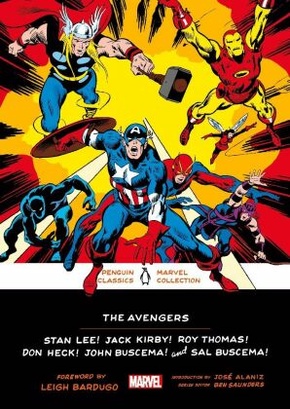| Verlag | Penguin US |
| Auflage | 2023 |
| Seiten | 400 |
| Format | 17,9 x 2,5 x 25,1 cm |
| Gewicht | 914 g |
| Artikeltyp | Englisches Buch |
| Reihe | Penguin Classics Marvel Collection 5 |
| EAN | 9780143135791 |
| Bestell-Nr | 14313579EA |
The Penguin Classics Marvel Collection presents the origin stories, seminal tales, and characters of the Marvel Universe to explore Marvel s transformative and timeless influence on an entire genre of fantasy
Collects The Avengers #1-4, 9, 16, 26, 28, 44, 57, 58, 71, 74, and 83. It is impossible to imagine American popular culture without Marvel Comics. For decades, Marvel has published groundbreaking visual narratives that sustain attention on multiple levels: as metaphors for the experience of difference and otherness; as meditations on the fluid nature of identity; and as high-water marks in the artistic tradition of American cartooning, to name a few.
Starting in 1961, Stan Lee, Jack Kirby, and their collaborators transformed the Super Hero genre with a series of new creations, including the Incredible Hulk, the Mighty Thor, and the Invincible Iron Man. In 1963, Lee and Kirby brought these characters together for the first time in a new magazine called The Avengers adding a resurrected Captain America shortly after. Over time the Avengers roster would frequently change, mirroring transformations in the Marvel Universe and the society that it reflected. This unique collection gathers key issues from the first few years of the series.
A foreword by Leigh Bardugo, a scholarly introduction and apparatus by José Alaniz, and a general series introduction by Ben Saunders offer further insight into the enduring significance of The Avengers and classic Marvel comics.
Rezension:
A groundbreaking example of comics representation in literature.
Publishers Weekly
Penguin provides introductory essays; superb analyses by the series editor, Ben Saunders; and extensive bibliographies.
Michael Dirda, The Washington Post
Stories become classics when generations of readers sort through them, talk about them, imitate them, and recommend them. In this case, baby boomers read them when they débuted, Gen X-ers grew up with their sequels, and millennials encountered them through Marvel movies. Each generation of fans initially fanboys, increasingly fangirls, and these days nonbinary fans, too found new ways not just to read the comics but to use them. That s how canons form. Amateurs and professionals, over decades, come to something like consensus about which books matter and why or else they love to argue about it, and we get to follow the arguments. Canons rise and fall, gain works and lose others, when one generation of people with the powe r to publish, teach, and edit diverges from the one before ... A top-flight comic by Kirby or his successor on Captain America, Jim Steranko barely needed words. You could follow the story just by watching the characters act and react. Thankfully, Penguin volumes do justice to these images. They reproduce sixties comics in bright, flat, colorful inks on thick white paper unlike the dot-based process used on old newsprint, but perhaps truer to their bold, thrill-chasing spirit.
Stephanie Burt, The New Yorker
As before, all three of these volumes re-present Professor Ben Saunders learned general series intro which does an excellent job of succinctly explaining the rise of Marvel Comics and the Marvel Method.
Forces of Geek

